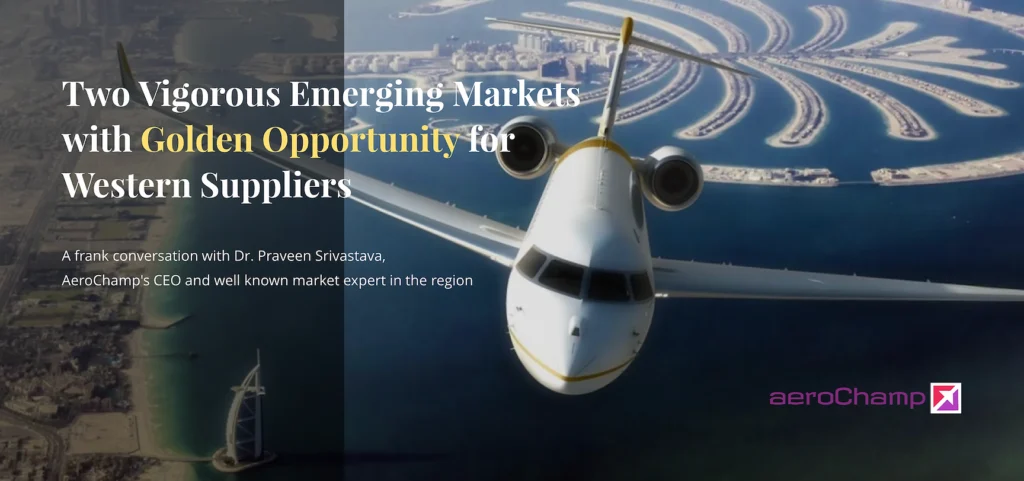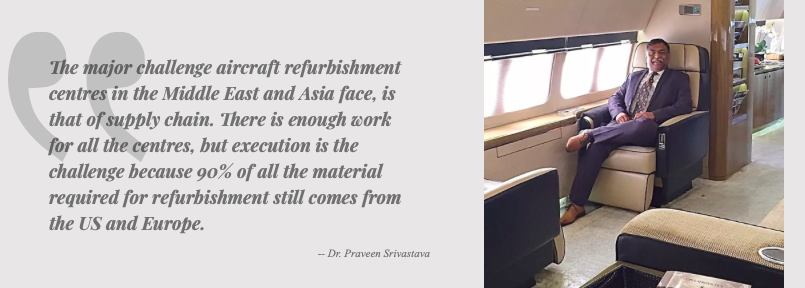Dr. Srivastava provides a detailed assessment of the burgeoning Middle East and Asian markets and how the new surge in demand is extending opportunity to supplier companies in Europe and the US. Read about the critical dynamics fueling these needs and the increasing high demand for products and services in both regions.

Q: Asia-Pacific is a high-growth and increasingly important market for both Business and Commercial aircraft. In fact, it was reported that China became the world’s largest domestic air traffic market in 2020. Would you agree with this statement, and if so, can you can help put a finer point on it? In broad terms, can you tell us why this is – and what your predictions are in terms its scope – and what its duration might be.
A: This is absolutely correct and statistics published by regulatory authorities show that Asia is a high-growth market for both Business and Commercial aircraft. In the last decade, the Middle East was highlighted as the fastest growing market and hence most of the OEMs focused on that region. However now the OEMs will undoubtably be shifting their focus to Asia. The reason is obvious – because the growth of air travel in Asia started much later, but it’s catching up fast now, while it has already plateaued in the west.
Air travel which once used to be the mode of travel for the elite in this region has become the most preferred mode for business travelers and those who can just afford it. Not only commercial air travel has seen high growth, but the business jet travel has also seen a surge in this region. Those who can’t buy a private jet, are utilizing charter to service their needs. More and more successful entrepreneurs, celebrities and senior corporate executives in Asia are opting to fly private.

Based on the projections by various research agencies, as well as my personal industry exposure in this region, I can see the graph moving upward for next 20 years. This is the most exciting time for the aviation industry in Asia and the Middle East. It’s the happening place, an emerging market that cannot be ignored. Eventually, it will reach a point where no OEM or major supplier can afford not to have a presence in the region.
Q: It seems a bit harder to quantify the Mid-East market. I mean it has long been a big market for VVIP aircraft, with so many heads of state flight departments and concentrated wealth in the region. But can you sort of expand on that for us and give us your predictions for growth in the interiors sector?
A: True, it is difficult to quantify the market due to the confidentiality of VVIP aircraft, but the financial figures show that the Mid-East has been a big market for private aircraft for certainly the past decade at least. As the Billionaire’s club bloats in the Middle East and Asia with the emergence of successful millennial entrepreneurs, the private aircraft market will only continue to grow. Heads of state, successful entrepreneurs and top executives are travelling more often than before – both within the region and to Europe; also the US for business and vacation spots. Their comfort and luxury needs must be met with plush and comfortable cabin interiors. Going by the growth in the number of private aircraft in this region in past 10 years and the projections for next 10, the aircraft interiors industry has a very bright future in this region. It wouldn’t be an overestimate to project the aircraft interiors industry tripling in size by 2035.
I have been privileged to have the opportunity to setup 4 aircraft interiors facilities and advise many interior shops in the Middle East and Asia in last 15 years- and all of them are thriving. From just 15-20 interior facilities in 2010, the number has grown more than 50 interior facilities in 2022, all in the Middle East and Asia. The numbers speak for themselves. With the addition of so many private aircraft and comfort enhancement in first and business class Airlines flying international, the need for interior refurbishment has a multifold growth profile. And it will continue to grow for next 20 years with the need for localization of refurbishment centers and interior goods suppliers. There is an abundance of trained manpower and skilled craftsmen in this region to deliver the quality – and with it, a lower infrastructure and labor costs. This has encouraged the private aircraft and airline operators to get their aircraft interior refurbishment done locally, rather than flying the aircraft long distance for the work. Some of the well-known interior refurbishment centres in Canada, US and Europe have established satellite facilities in Dubai and Singapore, and more will no doubt follow. The market in this region is getting to a level such that new localized completion centres will have to be setup soon to meet the regional taste and aesthetics.

Dr. Praveen Srivastava, CEO AeroChamp
Q: What are the factors that business jet completion and refurbishment centres in middle east & Asia region, consider while sourcing their products from US suppliers?
A: Currently there are no completion centres in the Middle East and Asia region, except one in Hong Kong, which has carried out 2-3 projects. There are over 50 refurbishment centres in this region, which do not have many options of interior suppliers. These aircraft interior refurbishment centres struggle to get their supplies on time and have to burn midnight oil coordinating with the US suppliers because of the time difference. Based on my experience as an aircraft interiors specialist in these regions, I have seen these refurbishment centres struggling for the right samples, availability of selected material, lead time and shipment challenges, which makes it very difficult for them in meeting the project timelines. Due to the customization of private aircraft interiors and the tendency of the customer to look for a change of colour and pattern at the time of refurbishment, it becomes very difficult for the refurbishment centres to coordinate with the US suppliers who are in a 12 hour time difference. It becomes difficult to offer a good variety of options to the customer and even when the soft goods are selected; to check the inventory and get the goods in time, remains a big challenge.
Some of the main factors refurbishment centres from this region look for are as follows:
- Regional presence of US suppliers to communicate in close time zone.
- Availability of latest samples with the regional distributor and inventory status.
- Shorter lead time – usually the lead time for most US suppliers who do not hold inventory is quite long and it varies for each item.
- Prompt shipment coordination – due to the time difference, moreover during the weekends it becomes very difficult to coordinate with the US suppliers.
- Friendly after sales service – there is a cultural difference between the east and the west, the customers in this region expect their requests to be accommodated.
- Smooth settlement of warranty claims – time is of essence during interior refurbishment of aircraft. If there is any delay for whatever reason, the refurbishment centre has to face the heat of the customer.
- Compliance – many suppliers from the US do not support special requests like country of origin certificate, veterinary certificate for leather and sheep skin and composition certificate for carpet and fabric, which is required for customs clearing in the country of import.
Q: Since the first article we did back near the trailing end of the pandemic (or so we thought), you hinted at very vigorous growth in private aircraft and the refurbishment of existing ones that had sat around on tarmacs during COVID. How do you assess the business aircraft interiors market now in your region?
A: My forecast based on analysis of the Middle East and Asia markets of the post Covid growth in private aircraft and the refurbishment of existing ones was accurate. This region has seen a surge of almost 30% in the number of private jets inducted in past 12 months. Also the interior refurbishment centres are busier than what they were before COVID. Based on data analysis and my experience in the region, I expect this trend to continue for next 4 – 5 years. Post COVID travel preferences of corporates, entrepreneurs and celebrities have changed, they are opting to charter a private jet more often, hence charter companies are doing well and adding more aircraft to their fleets.
Higher the number of private aircraft – more the opportunity for aircraft interior refurbishment centres. Based on my study, a private aircraft is partially or fully refurbished every 6 years in this region, so the chances of an aircraft undergoing full interior refurbishment during 4 or 8 yearly inspection is very high. Most regional charter operators and first-time private aircraft owners are buying pre-owned aircraft (in the 4-5 years old range), hence the market size of aircraft interior refurbishment industry in the Middle East and Asia should continue to grow at 20 – 25% per year, for next 4 – 5 years. This is the right time to create join ventures, strategic alliances and collaborations between the OEMs and suppliers from the west and local distributors in the east to tap the opportunities in this region.
Q: The company you founded, AeroChamp has been around now since 2018. I Think you have four separate business verticals now. You must be proud of that growth. Can you give our readers a better sense about the breadth of your service and product offerings – and what your goals are in the coming decade?
A: We started AeroChamp with a very clear vision – to offer products and services locally to the interior refurbishment centres, MROs, airlines and private aircraft operators in the Middle East and Asia. My journey into the aircraft interiors industry began way back in 2006 by representing a leading US based aircraft passenger seat manufacturer. I was fortunate enough to close very significant deals and capture a market share of more than 35% in the passenger seat sector. Slowly I developed expertise in business jet interior refurbishment and leveraging my background in material science and a PhD in aircraft maintenance, I was able to offer product and application solutions to the interiors sector. This established me as an aircraft interiors specialist in both the Asian and Middle East markets. Having setup 4 interior refurbishment facilities by now and having developed a good personal rapport with the global aircraft interiors fraternity, I cam to recognize a gap between the OEMs and suppliers from the US and Europe, and the fast growing aircraft interiors industry in this region. AeroChamp was established to fill that gap by utilizing our localized expertise and our seasoned experience in the aircraft interiors industry at large.
It gives me a sense of satisfaction that we have been able to achieve a few milestones in our endeavor to establish a strong supply chain by bringing the OEMs and suppliers closer to the customers (interior refurbishment centres and MROs). However, there is a long way to go and our dream is to facilitate every product or services provider in the aircraft interiors industry to reach their potential customers in this region, via AeroChamp, as an access point.
AeroChamp offers flexible options to the manufacturers, suppliers and services providers to utilize our expertise and customer base to expand their market reach in the Middle East and Asia. AeroChamp has a strong base of more than 800 customers from Turkey to Australia and New Zealand – and covering the whole of the Middle East, Asia and Oceania. We are strongly connected to more than 120+ interior refurbishment centres, 150+ airlines, 340+ private jet operators (charter, business jet and helicopter) and 200+ MROs (airframe and component repair shops).
We currently offer a robust set of options and are always open to discussing customization of our services based on the specific needs of other companies who may want to leverage our expertise. Among our offerings are: Representation and complete marketing services. Customised digital marketing solutions. Distribution of products and services – professional marketing, sales and logistics teams. Logistics support – we have a joint venture with one of the largest logistics companies in this region with warehouses in various countries – and finally, dedicated customer support desks – for companies which have an existing customer base and want to serve them better via our local reach.
We have ambitious plans for the coming decade and our company has invested in developing a design and development centre for aircraft interior products. We are currently supporting a few PMA manufacturers in the US and Europe on their design, development and testing of aircraft cabin parts. We have a team of experienced designers who work on Autocad, Catia, Solidworks, Creo and Ansys Fluent software.
We have a growing team of marketing and sales personnel with a keen knowledge of aircraft interiors, already supporting several companies in the region. We intend to strengthen this team further by offering our expertise to more OEMs and suppliers from the US and Europe.
Q: Most well-known business jet completion/ refurbishment centres seem to be in the US and Europe. In your opinion, what challenges do centres in the Middle-East & Asia face.
A: Since there are no commercial aircraft manufacturers in the Middle East and Asia, the business jet completion eco system did not develop in this region until the last decade when a few small refurbishment centres started springing up and finding quick growth. Those who sustained the initial turbulent phase in this region are now reaping the benefits, as this industry has entered a new growth phase.
The major challenge aircraft refurbishment centres in the Middle East and Asia face, is that of supply chain. There is enough work for all the refurbishment centres, but execution is the challenge because 90% of all the material required for refurbishment still comes from the US and Europe. Over the last decade, this region has trained large number of technicians and craftsmen but availability of the right materials at the right time, is still a challenge.
Leather, fabric, carpet, synthetic leather, cushion and even the sewing threads come from either US or Europe and many of the suppliers still like to operate from their central offices in their respective countries. Hence the refurbishment centres have to depend on supplier’s working hours. There is also of course, the cultural difference between the west and east, which further complicates the procurement process.
Gone are the days when it was a supplier’s market, now it’s a buyer’s market. If the suppliers don’t address this issue, they are only encouraging the refurbishment centres to look for alternate local products. I have seen some refurbishment centres in this region using locally manufactured carpets with fire retardant coating to meet FAR 25.853 compliance, due to the poor presence and support from the more recognized suppliers.
Q: In a general sense Dr. Srivastava, do you believe the current global landscape of major completion centers (by and large concentrated in the US and Europe) do a good job of servicing the current market? Or do you see room for major centres in your own region, perhaps India and/or the UAE (as examples)?
A: There is no doubt on the capability of major completion centers in the US and Europe, they are doing a great job and have the history to support it. They also maintain a good understanding of the aero structural design of aircraft cabins. The challenge is not in fabrication or completion of a green aircraft, but offering ongoing post-completion services – and doing it in a climate of constantly changing technology – which of course is essential in meeting the customer’s demands for relevant and timely upgrades. I have seen many large business jet owners struggling with their cabin entertainment system, lighting system and surface finishes. When you buy a $60,000 – $80,000 car, you look for a good and reliable post-sales service network of that brand, in your city or area. And people who own bizjets, want the same – especially considering the price tags are generally north of $20ML – not counting customized cabin interiors?
These completion centers will have to extend their support through independent support agencies such as AeroChamp or setup their own regional customer support desk. In the present scenario the business jet owners in this region are inconvenienced when they have to fly with a faulty or malfunctioning cabin, galley or lav equipment and wait for a flight to Europe or US to get it fixed or replaced.
Q: What factors do you consider important for business jet interior product manufacturers in western countries to expand their business in the Middle east & Asia region – or vice-versa?
Some of the more important factors business jet interior product manufacturers should consider in expanding their business to the Middle East and Asia are as follows:
- A strong local presence through companies which have domain knowledge related to their product and strong connect with the customers in the region.
- Regionally guided marketing activities that take advantage of the low manhour costs in Asia.
- Availability of samples which can reach the customers within 24 – 36 hours and a well-trained mobile sales team (which can be a shared resource) that are able to travel on short notice, in order to close business.
- The Outsourcing of customer and maintenance staff training to regional companies in order to reduce travel cost and provide prompt after sales support.
- Setup regional customer support desk (can also be a shared resource), for better coordination between the base team and customers (in most cases MROs and refurbishment centres) to reduce the time lag.
- Regional availability of frequently failing parts for quick support.
Q: Collaborations between aircraft interior related companies continues to be increasingly popular, especially in expanding capabilities to other continents or globally regional markets. Is this part of your own growth strategy for AeroChamp, and if so, what form do such collaborations take?
AeroChamp’s business philosophy has been: Collaborate, Coordinate and Cooperate – to create synergy for better returns. Business relationships essentially revolve around ROI, and each party in the relationship must benefit from the other. At AeroChamp we understand this very well and try to bring value to such collaborations via our domain knowledge, as well as the aircraft interiors industry in general and finally, our market reach within the Middle East and Asia region.
We invite aircraft interior product manufacturers to collaborate with us to expand their reach in the Middle East, Asia and Oceania. In the beginning our company, AeroChamp can introduce western products and services to the customers in this region and subsequently as the relationship strengthens, can offer to setup manufacturing facilities in Asia via joint venture. Based on our design and development capabilities, they may also find it valuable to outsource their development work to us – once again in leveraging benefit from the price competitiveness in Asia.
Q: What products & services of cabin interiors are having the highest penetration in your region among different aircraft applications?
Since this region is currently handling more of refurbishment work than completions, the replacement items like soft goods and surface finishing material have higher demand than the hardware items. We have seen increasing demand for interior products like carpet, leather, fabric, sidewall lining, underlay foam, cushion, wood veneer, lacquer, decorative metal plating, cabin lighting etc. In the cabin interior services, there is demand for cabin comfort enhancement solutions, cabin upgrade and modification technical support and DOA / DER services.
Q: Lastly Dr. Srivastava, I sometimes like to close with a more frivolous inquiry, so here goes: Given the opportunity, what jet would you own for yourself, where would your preferred routes be – and lastly what car would you slip into on deplaning?
If ever I am able to buy a private plane for myself, I would love to own a Gulfstream latest being the G800, in which I would like to add a touch of my daughter Pragati Srivastava’s design who is currently pursuing her bachelor’s in Architecture from Mumbai University and aspires to become a business jet interior designer. I love this plane for its sleek design and performance. My dream car is the Rolls Royce Phantom for now, but that may change with time 🙂


Recent Comments